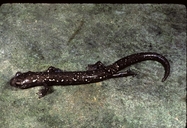|
Bolitoglossa riletti Holman, 1964
Rilett's climbing salamander, Rilett’s mushroomtongue salamander, Rilett’s salamander Subgenus: Oaxakia | family: Plethodontidae subfamily: Hemidactyliinae genus: Bolitoglossa |
 © 2010 David Wake (1 of 5) |
|
|
|
Description Bolitoglossa riletti has intermediately webbed hands and feet, whereas B. hermosa is fully webbed and B. macrinii has no webbing at all. Compared to B. macrinii in particular, B. riletti lacks maxillary teeth, but has undifferentiated vomerine and paravomerine teeth. It is only half as large as B. macrinii, with only a slight basal constriction on the tail, and has different coloration. Bolitoglossa riletti closely resembles B. rufescens with the only difference being in their foot structure. Compared to B. nigroflavescens, B. riletti has shorter legs that do not touch when adpressed, and has two costal folds between adpressed limbs. Bolitoglossa riletti has longer legs than B. brevipes, and B. brevipes shows five and a half costal folds between adpressed limbs (Papenfuss et al. 1983, Holman 1964). In life, its underside is bright yellow, and extends transversely across the pectoral region and down both sides of the specimens so the color is transverse to the body, anterior to the thighs, along with on the ventral area of the thighs. Adult coloration shows small cream-colored spots on dark skin, although the spots are scattered flecks in some individuals. In alcohol, the body and head are light brownish above, and show faint dorsolateral stripes. In the holotype, a middorsal stripe originates at the level of the hind legs, and continues to the back of the head where it bifurcates, and the bifurcation ends on the posteromedial borders of the eyelids. However, the middorsal stripe is only present in juveniles. The sides of both the head and body are dark brown, along with the legs. The chin has light yellow flecks, and the venter light gray (Holman 1964, Papenfuss et al. 1983). Some specimens show a dorsum mottled with yellow, and chin flecks in some individuals are reduced or lacking. The bifurcated mid-dorsal stripe ends right at the eyelids in juveniles, and ends behind the eyes in other individuals. Only sexually mature individuals show maxillary teeth (Holman 1964, Papenfuss et al. 1983). Distribution and Habitat Country distribution from AmphibiaWeb's database: Mexico
Life History, Abundance, Activity, and Special Behaviors There is little study that has been done regarding the reproductive behavior of B. riletti. However, direct development is common in Bolitoglossinae (Vitt and Caldwell 2009). Individuals collected during the dry season showed reduced reproductive organs, suggesting that breeding occurs during the rainy season (Holman 1964). Trends and Threats Relation to Humans Possible reasons for amphibian decline General habitat alteration and loss Comments Based on molecular evidence, Bolitoglossa riletti is part of the Oaxakia clade within Bolitoglossa. It is a sister species to B. hermosa, and both are sister species to B. zapoteca. Bolitoglossa macrinii and B. oaxacensis are outgroups within the same Oaxakia clade. (Parra-Olea et al. 2003) The species epithet “riletti” is named for Dr. R. Omar Riletti, an influential person behind the trip made by Ronald Altig, William Holmes Hill, and J. Alan Holman, who first described the species (Holman 1964). Bolitoglossa in general are unique in their defense mechanisms, utilizing a tail-lashing movement that exposes predators to poison gland secretions along the tail (Vitt and Caldwell 2009). Bolitoglossa are also physiologically unique in terms of their feeding technique. The tongue of Bolitoglossa is designed so that once the brain sends a signal to deploy it, the brain doesn’t have to send another to retract the tongue. The retractor muscles of the tongue are loose enough that they can contract at the same time as the extensor muscles and they won’t interfere with the trajectory of the tongue until it has reached its maximum length (Vitt and Caldwell 2009).
References
Canseco-Marquez, L., Gutierrez-Mayen, G. (2005). ''New Species of Pseudoeurycea (Caudata: Plethodontidae) from the Mountains of the Mixteca Region of Oaxaca, Mexico.'' Journal of Herpetology. 35, 2: 181-185. Holman, J. A. (1964). ''New and Interesting Amphibians and Reptiles from Guerrero and Oaxaca, Mexico.'' Herpetologica 20.1: 48-54. Ochoa-Ochoa, L., Urbina-Cardona, J. N., Vázquez, L.-B., Flores-Villela, O., and Bezaury-Creel, J. (2009). ''The effects of governmental protected areas and social initiatives for land protection on the conservation of Mexican amphibians.'' PLoS One, 4(9), e6878. Papenfuss, T. J., Wake, D. B., Adler, K. 1983. Salamanders of the Genus Bolitoglossa from the Sierra Madre Del Sur of Southern Mexico. Journal of Herpetology 17.4: 295-307. Parra-Olea, G., García-París, M., Wake, D. B. (2004). ''Molecular diversification of salamanders of the tropical American genus Bolitoglossa (Caudata: Plethodontidae) and its evolutionary and biogeographical implications.'' Biological Journal of the Linnean Society, 81, 325-346. Parra-Olea, G., Papenfuss, T. J., Wake, D. B. 2008. Bolitoglossa riletti. The IUCN Red List of Threatened Species. Version 2014.3. www.iucnredlist.org. Vitt, L. J., Caldwell, J. P. 2009. Herpetology 3rd ed. Elsevier Inc. Originally submitted by: Matthew Thorstensen, Lindsey Freeman, Naomi Cummings (first posted 2015-06-16) Edited by: Gordon Lau (2015-06-23) Species Account Citation: AmphibiaWeb 2015 Bolitoglossa riletti: Rilett's climbing salamander <https://amphibiaweb.org/species/4006> University of California, Berkeley, CA, USA. Accessed Nov 22, 2024.
Feedback or comments about this page.
Citation: AmphibiaWeb. 2024. <https://amphibiaweb.org> University of California, Berkeley, CA, USA. Accessed 22 Nov 2024. AmphibiaWeb's policy on data use. |



 Raffaëlli Account
Raffaëlli Account Map of Life
Map of Life